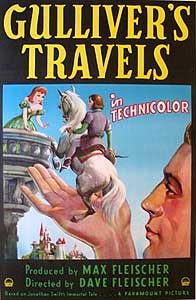 Gulliver's Travels (1939) has moments of startlingly beautiful animation, as with the opening sequence of Lemuel Gulliver's ship going down in a storm & him cast onto an island shore, & a later scene of Gulliver wading through the ocean pulling a line of little peoples' sailing ships.
Gulliver's Travels (1939) has moments of startlingly beautiful animation, as with the opening sequence of Lemuel Gulliver's ship going down in a storm & him cast onto an island shore, & a later scene of Gulliver wading through the ocean pulling a line of little peoples' sailing ships.
But for the majority of the film it is Disneyesque to such a high degree that it seems unoriginal. Fleischer Studios was attempting under Paramount's insistance to do what Disney had done with Snow White & the Seven Dwarfs (1937), somehow convinced it had to be done in the style of Disney rather than in Fleischer's distinct style that gave the world Betty Boop & Koko the Clown & Popeye the Sailor.
It was made in under two years, a very short time compared to Disney. Short cuts in the cell animation were possible by means of rotoscoping, a method developed at Fleischer studios & used most famously when Cab Calloway provided the dance moves of ghost-Koko & the walrus in the respective Betty Boop cartoons Snow White (1933) & Minnie the Moocher (1932).
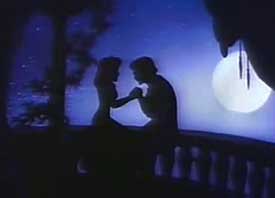 The Lilliputian "star" of the series is Gabby, voiced by vaudevillian & circus performer Pinto Colvig The Lilliputian "star" of the series is Gabby, voiced by vaudevillian & circus performer Pinto Colvig
Colvig had been the very first Bozo the Clown. He had already voiced at least one of the Munchkins in Wizard of Oz & both Sleepy & Grumpy in Snow White & the Seven Dwarfs, besides being the voice of Disney's Goofy.
Gabby is the town crier. When Gabby singing "All's Well" in that munchkin voice, it is way too similar to the "Hi Ho" work song of the seven dwarfs.
Gabby finds an unconscious giant washed ashore, & goes into a panic. He rushes to the King Little's castle, where a marriage is being planned for Princess Glory & Prince David (Jessica Dragonette & Lanny Ross), who look exactly like Disney's Cinderella & Prince Charming. They seem to come from a totally different race than their parents, as they're normally proportioned whereas everybody else appear to be dwarfs.
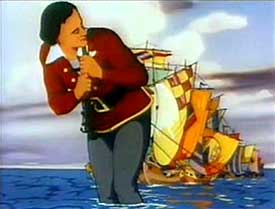 Hysterical Gabby tries to convince everyone, "There's a giant on the beach! There's a giant on the beach!" No one listens to the town crier's fit, as the two kings are losing their tempers with each other. Hysterical Gabby tries to convince everyone, "There's a giant on the beach! There's a giant on the beach!" No one listens to the town crier's fit, as the two kings are losing their tempers with each other.
Prince David's song is "Forever" & Princess Glory's song is "Faithful." The kings disagree which will be the wedding song. The wedding ends up called off, to the sadness of David & Glory.
The rest of the first half of the film is the Lilliputians tying up Gulliver while he's unconscious, only to have him wake up & break the ropes at once. The second half is about the rival king's naval assault on Lilliput, & Gulliver's efforts to put an end to the war & get David & Glory back together, assisted throughout by Gabby. Gulliver has his theme song, & sings, "I Hear a Dream All Day."
It's all headed to a happy ending of course, resolved with so simple a suggestion that even preschoolers will get it.
Considering the haste with which the film was made, it is not at all badly done, but being so imitation-Disney, the lack of originality forces the viewer to notice that Snow White & Seven Dwarfs is a hundred times better, whether assessed for design, character deliniation, story, or variety of event.
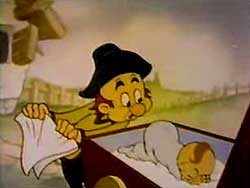 Gabby was spun out of the feature-length cartoon for his own shortlived series of short cartoons. And his two songs, "All's Well" & "It's a Hap Hap Happy Day," would trade off as the theme songs for his short-cartoon appearances.
Gabby was spun out of the feature-length cartoon for his own shortlived series of short cartoons. And his two songs, "All's Well" & "It's a Hap Hap Happy Day," would trade off as the theme songs for his short-cartoon appearances.
"Hap Hap Happy" would also be heard as an instrumental on the soundtrack of many post-Gulliver cartoons from Famous Studios, Paramount's successor to Fleischer Studios.
In King for a Day (1940), Gabby's a mail delivery man in Lilliput, rather than town crier as in Gulliver's Travels. He brings a letter to King Little , the contents of which so worries the king (a childlike coward at heart) that he decides to let Gabby be king for a day, as the letter says "I have orders to shoot you."
I guessed right off the bat that it was a photographer coming to shoot a portrait. But even not being surprised by the likeliest conclusion, Gabby as king is the real meat of the comedic story.
"Now you run things just as you want to, Gabby," says King Little, who slips away to hide. Instead of changing the way the kingdom runs as he first planned, Gabby finds the letter with the promise to shoot the king.
Now Gabby just wants to give the crown back to the king. He runs about the palace scared & crying, assaulted by his own fears & clumsiness.
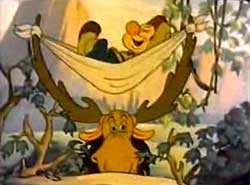 There were eight Gabby cartoons after Gulliver's Travels was released, generally using as their theme song an instrumental of the tune that gets its even the lyrics reprised in what would be the last Gabby cartoon,It's a Hap Hap Happy Day (1941).
There were eight Gabby cartoons after Gulliver's Travels was released, generally using as their theme song an instrumental of the tune that gets its even the lyrics reprised in what would be the last Gabby cartoon,It's a Hap Hap Happy Day (1941).
Gabby plays a lamplighter this time, singing & snuffing the candles at dawn. He sees the mayor of the town is going camping, & invites himself along. The mayor discourages him as much as possible but Gabby can't be discouraged, so the mayor has to ditch the pest.
Unditchable Gabby tags along, never shutting his mouth for a second, being Gabby after all. He causes grief after grief, the gags all relying on Gabby's certainty that he knows all about camping & the mayor doesn't when the opposite is true. It's really not that funny.
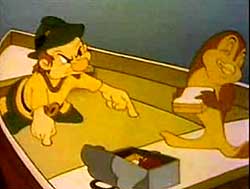 With a continuing shortage of original ideas, Gabby goes camping in It's a Hap Hap Happy Day, & he goes fishing in Gabby Goes Fishing (1941).
With a continuing shortage of original ideas, Gabby goes camping in It's a Hap Hap Happy Day, & he goes fishing in Gabby Goes Fishing (1941).
This time he decides to be helpful to a tow-headed Lilliputian lad who doesn't need his advice, but gets it anyway.
He takes over & wrecks the day for the kid, who we can only hope gets revenge someday. One of the fish recognizing a phony when he sees him pretty much starts teasing & bullying Gabby. Gabby calls it "a battle of wits!" which of course means Gabby's in for the worst of it.
The tow-headed child is written out of the story without explanation as Gabby wars with the fish. It sinks his boat, eats his lunch, & the tow-headed boy shows up at the very end to save Gabby with a fishnet. With stories this lame, it's no wonder Gabby didn't last long as a series character.
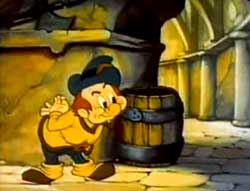 With the title Swing Cleaning (1941) it seemed likely that this Gabby adventure just might include swing music.
With the title Swing Cleaning (1941) it seemed likely that this Gabby adventure just might include swing music.
It's spring & everyone in the Lilliputian castle in is doing spring cleaning. Gabby wanders into the castle & sinceh's the perennial expert in everything, he claims that spring cleaning is his specialty.
He takes over the leadership of the cleaning crew & begins setting everything to ruin, destroying workers' efforts & successes without every apologizing or taking responsibility for any of his injurious behaviors.
At the end he is rewarded by the king & by all the injured workers with a well deserved beating. It's been another not-very-funny Gabby tale. And by the by, no swing music either.
 For All's Well (1941), Gabby is singing "All's Well" which is pretty much the same as "It's a Hap Hap Happy Day" with different lyrics.
For All's Well (1941), Gabby is singing "All's Well" which is pretty much the same as "It's a Hap Hap Happy Day" with different lyrics.
As he sings, Gabby wanders about the town of Lilliput trying to do good deeds. He's on a roll until he finds a baby that apparently needs its diaper changed.
That the baby carriage seems totally unattended is never explained. It was probably abandoned for being a shit.
If anyone deserved to be abused by this shit, it's a big shit like Gabby, even though this is one of the few cartoons wherein Gabby seems to want to do good, so there's no sense of him getting a come-uppance.
The baby keeps getting the better of Gabby until he ends up accidentally diapering himself. The gags are pretty slim, milk bottle slapped in the Gabby's face being representative. And never was it more obvious than in the Gabby cartoons that Fleischer's golden star was fading.
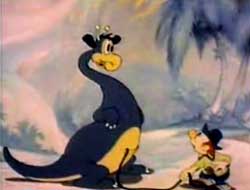 In Two for the Zoo (1941) Gabby has a basket of apples. A deliveryman is taking a box containing a "rubber neck kango" to the zoo. Gabby never heard of a kango but insists he's the the expert on kangos & takes over the delivery.
In Two for the Zoo (1941) Gabby has a basket of apples. A deliveryman is taking a box containing a "rubber neck kango" to the zoo. Gabby never heard of a kango but insists he's the the expert on kangos & takes over the delivery.
The giant kango mommy & its baby proceed to bamboozle the annoying little braggart's expertise. Gabby doesn't realize there are two of them & keeps thinking it's changing sizes, first tiny, then gigantic.
It's a nice animal actually; but, being in the hands of a fool, trouble happens. The biggest ongoing gag is how Gabby tries to cure the kango of hiccoughs.
The extent of the gags are pretty much exemplified by Gabby getting his head stuck in a bucket. Not exactly hilarious.
For climax the mommy kango finally gets mad at Gabby when he becomes abusive toward the infant. Abusing a baby! Gabby really is a piece of scum.
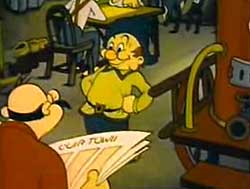 Fleischer Studios should've hired an eight year old to come up with better puns for them. Fire Cheese (1941) is a pun on "Fire Chief" without much context beyond this whole set of films being cheesy.
Fleischer Studios should've hired an eight year old to come up with better puns for them. Fire Cheese (1941) is a pun on "Fire Chief" without much context beyond this whole set of films being cheesy.
Gabby decides he knows more about fighting fires than does the Lilliput fire department, & sets out to do his usual harmful antics.
He interrupts the fire fight at every turn doing pretty much the opposite of what needs to be done, a menacing little s.o.b., as the house they could've saved is burnt to the ground thanks to Gabby.
There is one more Gabby cartoon I've not seen The Constable (1940), in which Gabby plays a policeman in Lilliput trying to solve the crime of pig-theft. To my surprise I saw a nineth cartoon in a Gabby filmography at Wickipedia, Gabby Goes to the Pound (1941), which is probably a phantom film, i.e., non-existent.
copyright © by Paghat the Ratgirl
|
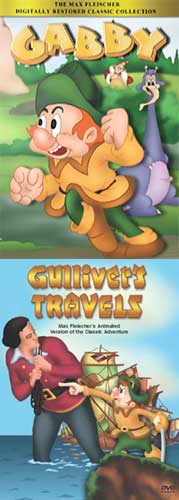

 The Lilliputian "star" of the series is Gabby, voiced by vaudevillian & circus performer Pinto Colvig
The Lilliputian "star" of the series is Gabby, voiced by vaudevillian & circus performer Pinto Colvig Hysterical Gabby tries to convince everyone, "There's a giant on the beach! There's a giant on the beach!" No one listens to the town crier's fit, as the two kings are losing their tempers with each other.
Hysterical Gabby tries to convince everyone, "There's a giant on the beach! There's a giant on the beach!" No one listens to the town crier's fit, as the two kings are losing their tempers with each other.




